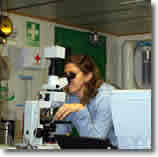Phytoplankton Rx
 This fluorescence can be impacted
by various environmental factors such as iron, light, and macronutrient concentrations. One of the advantages
of measuring this fluorescence is that it allows us to ascertain the health of the phytoplankton assemblage
in near real time. Nearly anything that stresses the algae will cause a decrease in fluorescence, but we
handle the samples in a uniform manner to better understand the status of the phytoplankton, especially
in assessing potential iron limitation. This is important to us since the phytoplankton bloom in the Ross Sea
is believed to be seasonally limited by iron.
This fluorescence can be impacted
by various environmental factors such as iron, light, and macronutrient concentrations. One of the advantages
of measuring this fluorescence is that it allows us to ascertain the health of the phytoplankton assemblage
in near real time. Nearly anything that stresses the algae will cause a decrease in fluorescence, but we
handle the samples in a uniform manner to better understand the status of the phytoplankton, especially
in assessing potential iron limitation. This is important to us since the phytoplankton bloom in the Ross Sea
is believed to be seasonally limited by iron.
We also analyze fluorescence on a single-celled basis. This is an extremely laborious procedure that involves putting a sample under a microscope, illuminating a single cell with pulses of light, and measuring the fluorescence of only that cell. Because the phytoplankton are composed of many different kinds of species, this technique can determine the different types of responses to various oceanographic conditions. We are using this to better understand why Phaeocystis antarctica or diatoms dominate in certain areas of the Ross Sea. We also conduct experiments by collecting water, adding various materials (such as iron or inhibitors of the uptake of silicon, an essential component of diatoms) to test the response. Because all phytoplankton are not alike in their responses, and because each has a unique role in the food web and the regional biogeochemical cycle, this approach allows us to understand how efficiently each taxon is operating in a given set of environmental conditions.

